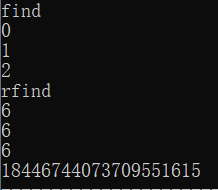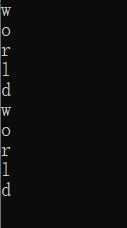C++ STL摘记
1. string类补充
1.1. 函数-find/rfind
find和rfind函数,返回的是下标或者string::npos
index=ss.find(s1,pos,num)
find从pos(包括)开始往右查找(num的作用待补充)
index=ss.rfind(s1,poss,num)
rfind从pos(包括)开始往左查找(num的作用待补充)
代码示例:
//>>>>Qiansui #include<iostream> #include<algorithm> #include<cmath> #define ll long long using namespace std; const int maxm=1e4+5; string ss[3]{"123asd123","a123gh123","ea123s123"},s1="123"; int main(){ int index; cout<<"find\n"; for(int i=0;i<3;++i){ index=ss[i].find(s1); if(index!=string::npos) cout<<index<<endl; else cout<<"Error\n"; } cout<<"rfind\n"; for(int i=0;i<3;++i){ index=ss[i].rfind(s1,6); if(index!=string::npos) cout<<index<<endl; else cout<<"Error\n"; } cout<<string::npos; return 0; }
运行结果:

1.2. 遍历
代码示例:
#include<iostream> #include <string> using namespace std; int main(){ string s1{"world"}; for(int i=0;i<s1.size(); ++i) cout<<s1[i]<<endl; for(auto c : s1) cout<<c<<endl; return 0; }
运行结果:

1.3. string的修改器
push_back()和pop_back()实现string类对象的前后的单个字符的改变
string ss; char ch='a'; ss.push_back(ch);//Append character to string (public member function) cout<<ss<<"\n"; ss.push_back('b'); cout<<ss<<"\n"; ss.pop_back();//Delete last character (public member function) cout<<ss<<'\n'; /* a ab a */
2. STL函数
头文件:#include<algorithm>
2.1. reverse函数
https://en.cppreference.com/w/cpp/algorithm/reverse
可以翻转数组、字符串、容器等
reverse函数用于反转在[first,last)范围内的顺序[first,last)(左闭右开),reverse函数没有返回值
例题:
简单的翻转 https://atcoder.jp/contests/abc284/tasks/abc284_a?lang=en vector<string>
2.2. fill函数
用于对容器的值进行填充,可以填充普通数组、vector等
fill(a.begin(),a.end(),10); int arr[10]; fill(arr, arr + 10, 2);
相关资料:
2.3. unique函数
该函数的作用是“去除”容器或者数组中相邻元素的重复出现的元素
返回值是一个迭代器,它指向的是去重后容器中不重复序列的最后一个元素的下一个元素。
sort(ans.begin(), ans.end()); ans.erase(unique(ans.begin(), ans.end()), ans.end());
相关资料:
https://www.cnblogs.com/wangkundentisy/p/9033782.html
https://blog.csdn.net/qq_36561697/article/details/82356053
3. priority_queue 优先队列
头文件#include<queue>
3.1. 相关资料
https://blog.csdn.net/c20182030/article/details/70757660
3.2. 摘记
- 默认从大到小,如:
priority_queue<int> a; a.push(1); cout<<a.top()<<'\n'; a.push(10); cout<<a.top()<<'\n'; a.push(8); cout<<a.top()<<'\n'; a.push(3); cout<<a.top()<<'\n'; while(a.size()){ cout<<a.size()<<" "<<a.top()<<'\n'; a.pop(); } return ;

greater<int>——从小到大——priority_queue<int,vector<int>,greater<int>> a
less<int>——从大到小——priority_queue<int,vector<int>,less<int>> a
top返回第一个,pop删除第一个,即队列头
3.3. 自定义排序
struct node{ ll val,id,c; bool operator <(const node &a)const{ return a.val<val;//必须重载小于号和使用小于号 } }; priority_queue<node> q;//此处为最小堆
4. multiset
c++语言中,multiset是set库中一个非常有用的类型,它可以看成一个序列,插入一个数,删除一个数都能够在O(logn)的时间内完成,而且他能时刻保证序列中的数是有序的,而且序列中可以存在重复的数。
4.1. 操作
c.erase(elem) 删除与elem相等的所有元素,返回被移除的元素个数。
4.2. 相关资料
multiset用法总结 https://blog.csdn.net/sodacoco/article/details/84798621
4.3. 例题
双multiset维护数组的k个最大值Best Performances做法见提交和题解
5. map
map 由红黑树实现,插入、查找、删除的时间复杂度近似为
unordered_map 由哈希表实现,插入、查找的时间复杂度为
5.1. unordered_map 自定义哈希函数
struct custom_hash { static uint64_t splitmix64(uint64_t x) { x += 0x9e3779b97f4a7c15; x = (x ^ (x >> 30)) * 0xbf58476d1ce4e5b9; x = (x ^ (x >> 27)) * 0x94d049bb133111eb; return x ^ (x >> 31); } size_t operator()(uint64_t x) const { static const uint64_t FIXED_RANDOM = chrono::steady_clock::now().time_since_epoch().count(); return splitmix64(x + FIXED_RANDOM); } }; unordered_map<int, int, custom_hash> c;
5.2. 相关资料
map的默认排序和自定义排序 https://www.cnblogs.com/stay-alive/p/8215400.html
6. vector
类似于数组的容器,但是动态扩容(细节不清楚,日后摘记)
7. std :: function
例如:
void solve(){ function <void(int, int)> output = [](int x, int y) -> void { cout << x + y << '\n'; }; auto output2 = [](int x, int y){ return x + y; }; output(1, 2); cout << output2(2, 34) << '\n'; return ; }
8. 末尾 - 杂项(此处不一定都是STL的内容)
8.1. STL 自定义排序
参考链接:https://zhuanlan.zhihu.com/p/600531550
远古图片,保留一下哈哈哈~

8.2. memset 函数
头文件:C 中 #include<string.h> ,C++ 中 #include<cstring>
memset 是按字节赋值,而 int 有 4 个字节,所以 memset(a, 127, sizeof(a)) 不是将 a 全赋 127,而是赋了一个很大很大的数(
8.3. __lg() 函数和 log2() 函数
__lg() 函数接受一个整数,返回一个整数,表示该数二进制表示下最高一位 1 的位置。事实上这个数就是
log2() 函数接受一个浮点数,返回一个浮点数,表示该数以 2 为底的对数的具体值。由于是浮点数,因此精度有限。当输入的数绝对值很大时,很可能最终结果与准确值相差 eps。
本文来自博客园,作者:Qiansui,转载请注明原文链接:https://www.cnblogs.com/Qiansui/p/17255679.html




【推荐】国内首个AI IDE,深度理解中文开发场景,立即下载体验Trae
【推荐】编程新体验,更懂你的AI,立即体验豆包MarsCode编程助手
【推荐】抖音旗下AI助手豆包,你的智能百科全书,全免费不限次数
【推荐】轻量又高性能的 SSH 工具 IShell:AI 加持,快人一步
· 使用C#创建一个MCP客户端
· 分享一个免费、快速、无限量使用的满血 DeepSeek R1 模型,支持深度思考和联网搜索!
· ollama系列1:轻松3步本地部署deepseek,普通电脑可用
· 基于 Docker 搭建 FRP 内网穿透开源项目(很简单哒)
· 按钮权限的设计及实现